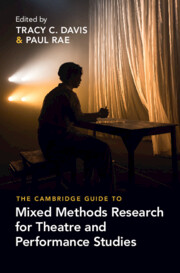Book contents
- The Cambridge Guide to Mixed Methods Research for Theatre and Performance Studies
- Reviews
- The Cambridge Guide to Mixed Methods Research for Theatre and Performance Studies
- Copyright page
- Contents
- Figures
- Tables
- Contributors
- Acknowledgements
- Introduction:
- Part I Planning
- Part II Doing
- Chapter 6 You’re Already a Digital Humanist:
- Chapter 7 Analysing Immersive Performance through Lived Bricolage
- Chapter 8 Talking Theatre in an Oral Culture:
- Chapter 9 Painful Fieldwork?
- Chapter 10 Fieldwork as Method in Theatre and Performance Studies
- Part III Interpreting
- Index
- References
Chapter 6 - You’re Already a Digital Humanist:
Why Aren’t You Thinking Like One?
from Part II - Doing
Published online by Cambridge University Press: 01 February 2024
- The Cambridge Guide to Mixed Methods Research for Theatre and Performance Studies
- Reviews
- The Cambridge Guide to Mixed Methods Research for Theatre and Performance Studies
- Copyright page
- Contents
- Figures
- Tables
- Contributors
- Acknowledgements
- Introduction:
- Part I Planning
- Part II Doing
- Chapter 6 You’re Already a Digital Humanist:
- Chapter 7 Analysing Immersive Performance through Lived Bricolage
- Chapter 8 Talking Theatre in an Oral Culture:
- Chapter 9 Painful Fieldwork?
- Chapter 10 Fieldwork as Method in Theatre and Performance Studies
- Part III Interpreting
- Index
- References
Summary
This chapter introduces data-driven research methods for theatre and performance. Drawing on two case studies, the chapter demonstrates how to define and identify data, how to collect and organize it, and how to analyse it through computational methods. Careful attention is paid to the tension between a rigorous data model and the uncertainty and ‘messiness’ present in data’s sources. The conclusion promotes data-driven thinking as a way to expand the context and scope of TaPS analyses and to encourage explicit reflection on the mental categories and models within which we understand performance.
- Type
- Chapter
- Information
- Publisher: Cambridge University PressPrint publication year: 2024



